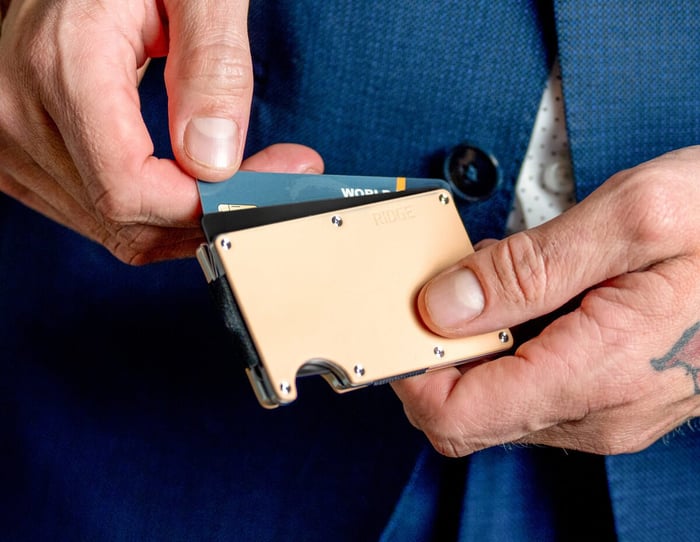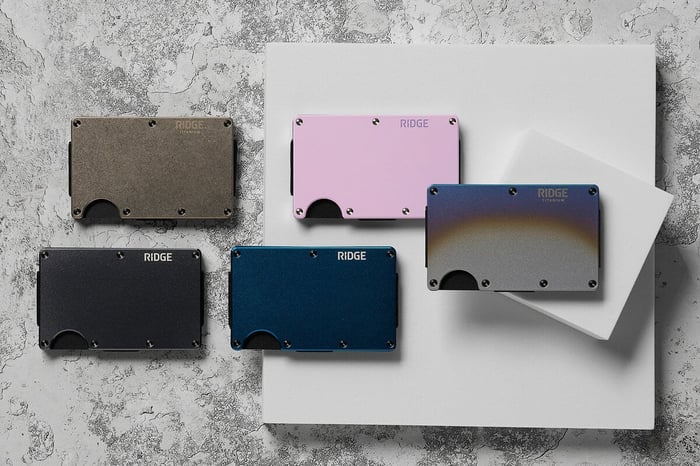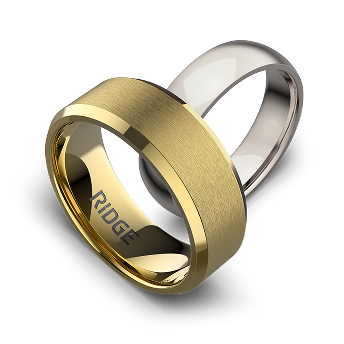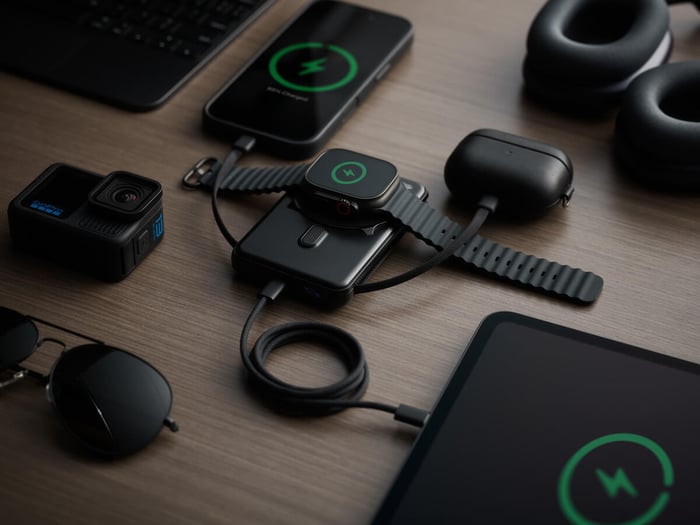Credit card fraud and identity theft are major problems in the United States. According to the National Council on Identity Theft, cases of credit card fraud are up 70% compared to 2020. Worse yet, credit card theft cost Americans a staggering $5.8 billion in 2025 alone.
It gets even more worrying.
According to Experian, the Federal Trade Commission (FTC) reported 1,434,695 cases of identity theft in 2025. This figure comprises 24% of all fraud, identity theft, and similar complaints made throughout the year.
The message is simple:
If you’re a cardholder, you’re at risk. However, that risk may not come from where you’d think. Today, many cases of identity and credit card theft are perpetrated by hackers who take advantage of RFID technology. They steal the details from RFID-enabled credit cards, allowing them to perpetrate scams and gain access to sensitive information.
You can protect yourself from these issues with an RFID-blocking wallet. But what is RFID wallet? How does it work, and why is it capable of protecting your card details? We answer those questions in this article.
What Is RFID?
Before we go any further, we need to establish RFID’s meaning.
RFID stands for radio frequency identification, and it refers to a wireless system that comprises two components:
Tags
Readers
Many items, such as contactless cards, contain RFID tags. These tags hold information about the item, such as the card’s details in the case of credit or debit cards. The tags also emit radio waves, essentially creating small electromagnetic fields around themselves. Think of this tag as a little RFID chip.
These tags can be active or passive.
In the case of an active RFID chip, the tag has a battery. As a result, it doesn’t require a reader to power it. By contrast, a passive tag does require a reader.
Speaking of the RFID reader, this is a device that contains antennas that emit radio waves. The reader receives the RFID signals a tag emits, allowing the device to read the data provided. For example, a reader designed for credit cards can read a card number and associated details.
Examples of RFID technology in action include:
Credit cards
Debit cards
ID cards
Robbery-proof chips in casinos
Guns
Passes for amusement parks

Why Is It So Risky?
RFID is an exceptionally convenient technology. Anybody who’s used a contactless card to checkout at a retailer’s establishment can tell you that. Instead of going through the time-consuming process of swiping the card and entering details, you just tap the card against a reader to make a payment.
Unfortunately, that convenience comes at a cost.
Criminals have developed techniques to keep up with new technology. Where pickpocketing may have been your primary concern in the past, RFID skimmers are a much bigger concern today.
Hackers use their own readers to steal the sensitive information contained in RFID tags. For example, let’s say you keep your credit cards in a leather bifold wallet. A hacker could use a card reader to steal your credit card number and data, allowing them to create duplicate cards they can use to purchase products using your money.
You won’t even know your details were stolen until it’s too late.
RFID skimming is one of the greatest threats that exist in the world of credit card fraud. Sadly, traditional wallets aren’t capable of deterring a hacker with an RFID scanner.
What Is an RFID Wallet?
Now that you know how RFID works, there’s a key question to answer:
What is an RFID protection wallet?
An RFID wallet implements a layer of protection that prevents your cards’ RFID tags from emitting radio signals. This protection usually comes in the form of a metal barrier, with modern RFID wallets using aluminum, carbon fiber, or titanium.
The barrier acts as a Faraday Cage. As a result, it cancels the electromagnetic signals your card gives out, making it impossible for hackers to steal your credit card information. The signals only emit once you remove the card from the wallet, allowing you to make a contactless payment or swipe your ID before returning the card to safety.
RFID wallets work by acting as armor for your cards. You get peace of mind because you no longer have to worry about skimmers stealing sensitive information.

Why You Need an RFID Wallet
RFID blocking technology implemented into wallets protects your cards. Here are the key benefits of these minimalist wallets.
Security
As mentioned, an RFID wallet provides security by preventing hackers from using a scanner to read the electromagnetic signals that RFID tags emit.
Here’s what can happen if you don’t have this layer of security.
Imagine you’re casually walking down the street, and you see somebody coming toward you. That somebody is a hacker, though you have no way of knowing that information. As the hacker passes, they use a discreet RFID reader to scan for any RFID-enabled cards in your wallet. If you have no protection, the hacker’s reader scans your cards and steals your information.
That can’t happen if you have an RFID-blocking card wallet. The RFID block disrupts the signals, making them impossible to read.
Physical Protection for Your Cards
You get more than technological protection from an RFID wallet.
As they’re typically made using metal, RFID wallets also offer physical protection. You’re wrapping your cards in a solid metal casing, meaning they’re less susceptible to crushing or cracking.
This benefit is ideal for those who lead active lifestyles. You don’t have to worry about your cards getting damaged if your wallet falls out of your pocket or gets crushed against a wall. An RFID wallet protects your cards in both cases.
Same Look and Feel as a Regular Wallet
Many people point to the minimalist style RFID wallets often have as a way to differentiate them from traditional wallets.
However, you can get RFID-blocking wallets in a range of styles.
For minimalists, a simple card holder with a money clip allows them to carry the essentials. It also gives them a wallet they can store in any pocket without creating bulges or creases.
If you prefer the traditional look, you can get bifold and trifold wallets that offer RFID protection. These wallets typically combine traditional materials, such as leather, with metal plates that block RFID signals.
The Future of RFID Wallets
We’ve answered the question, “what is an RFID-blocking wallet?”
Now it’s time to look to the future. How will RFID wallets evolve?
Before answering that question, we need to look to the past to see how these wallets have changed over the years. After all, RFID isn’t an emerging technology. Radio frequency identification technology has been in use since World War II, with the first commercial patents involving the technology emerging in the 1970s.
However, it wasn’t until 2005 that we saw the technology implemented into credit cards in the United States. During these early days, wallet owners had to go to strange lengths to guard their cards. For example, some wrapped their cards in aluminum foil to block their signals.
The first RFID-blocking wallets emerged soon after credit card companies started using RFID tags. These early wallets were often bulky or so minimalist that they didn’t offer everything a consumer needed from a wallet.
Today’s RFID wallets are much more practical. They often combine their RFID-blocking tech with money clips, coin drawers, and similar concepts to create attractive and slimline designs.
As for the future, it’s likely we’ll see RFID fabrics become popular. Current RFID wallets use metal cases to block signals. However, engineers are already creating RFID fabrics that will offer more customizability in wallet creation. Currently, these fabrics are extremely expensive, with some selling in excess of $1,000. But as the technology becomes more affordable, it’s likely that we’ll see new ranges of fabric RFID-blocking wallets in the future.
Is the Ridge Wallet Right for You?
There’s one more question to answer:
What is the best RFID wallet?
The Ridge has the perfect selection of RFID wallets for men and women. Available in a variety of styles and colors, the wallets combine modern aesthetics with practicality.
What do you get with a Ridge wallet?
The choice between aluminum, carbon fiber, and titanium materials
The ability to add a cash strap, money clip, or both to your wallet
A lifetime guarantee that ensures you can always replace your wallet if it’s faulty
Scratch-resistant technology that protects the wallet as well as the cards inside
A 99-day free trial that lets you take your new wallet on a test drive before you commit to it
The ability to hold up to 12 cards in a single wallet
If you’d like to learn more, check out The Ridge RFID wallet today.
FAQs
We’ve answered the most common questions about the RFID wallet. What is it and what are its benefits have already been covered. But here are a few other frequently asked questions.
Does RFID blocking work?
RFID blocking works by preventing your cards from transmitting electromagnetic signals that hackers can skim using RFID readers. Think of the technology as a barrier. Nothing can access your cards until you choose to take them out of your wallet.
Does RFID blocking prevent identity theft?
Identity theft happens whenever somebody steals your personal information so they can assume your identity. In the case of credit card fraud, this involves stealing credit card details and cloning your card, allowing the hacker to purchase items using your money.
Identity theft impacts people financially and can lead to psychological issues, including feelings of helplessness and betrayal.
RFID blocking helps to prevent identity theft by ensuring hackers can’t steal sensitive information from your cards. In addition to preventing theft, this also stops hackers from stealing details from ID cards that would give them access to sensitive locations and materials.
Is an RFID wallet really necessary?
RFID wallets are necessary for anybody who wants peace of mind. They’re especially important when traveling to ensure your card details aren’t stolen by international hackers.
How can I tell if my wallet is RFID protected?
If a retailer doesn’t mention that a wallet contains RFID-blocking technology, always assume it doesn’t have any. The retailer will usually tell you if their wallet blocks RFID signals.

Evan Grimm, Writer
Evan Grimm is a practical writer, blogger, editor, and knowledgeable up-and-coming authority in the outdoor realm. His best-known content is published on Bowhunting.com, The Alaska Frontier, and Exodus Outdoor Gear. He and his family reside in central Alaska, where daily common sense and practicality are necessary. His commercial pilot and aircraft technician certifications make him focus on what is relevant and solidly provable. You will find him writing or proving more content.











































